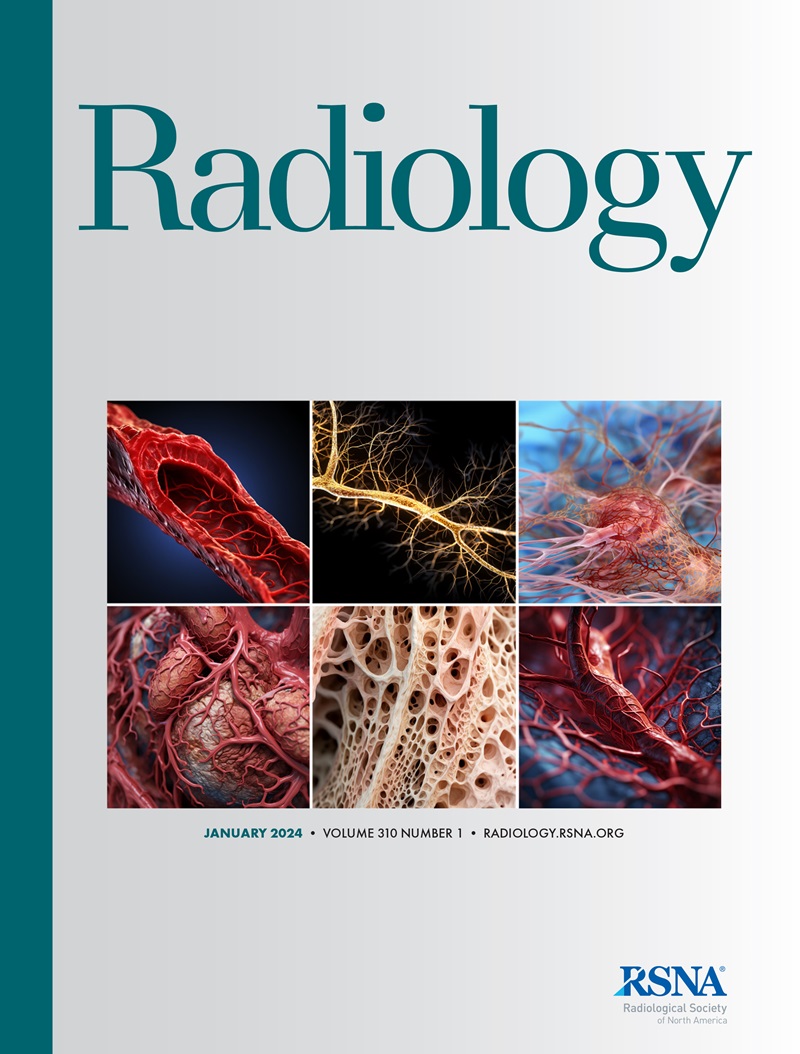Metabolic Dysfunction-Associated Steatotic Liver Disease at Quantitative US: International Prospective Study.
IF 12.1
1区 医学
Q1 RADIOLOGY, NUCLEAR MEDICINE & MEDICAL IMAGING
Tong-Yi Huang, Zhi-Yan Li, Jie Tian, Xiao-Juan Xie, Jeong Min Lee, Xin-Ping Ren, Xiao-Yan Xie
求助PDF
{"title":"Metabolic Dysfunction-Associated Steatotic Liver Disease at Quantitative US: International Prospective Study.","authors":"Tong-Yi Huang, Zhi-Yan Li, Jie Tian, Xiao-Juan Xie, Jeong Min Lee, Xin-Ping Ren, Xiao-Yan Xie","doi":"10.1148/radiol.242564","DOIUrl":null,"url":null,"abstract":"<p><p>Background Quantitative US is promising in assessing metabolic dysfunction-associated steatotic liver disease (MASLD), but prospective multicenter studies are lacking. Purpose To evaluate the diagnostic performance of quantitative US in assessing MASLD and metabolic dysfunction-associated steatohepatitis (MASH). Materials and Methods This prospective study included participants with MASLD from tertiary hospitals in China and Korea, undergoing multiparametric US from August 2021 to December 2023. Diagnostic performance of tissue attenuation imaging (TAI), tissue scatter-distribution imaging (TSI), and two-dimensional shear-wave elastography (SWE) parameters for assessment of MASLD and MASH was evaluated using area under the receiver operating characteristic curve (AUC) analysis, with histopathologic analysis as a reference. Univariable and multivariable analyses identified clinical factors associated with each US parameter. Results A total of 114 participants (median age, 40 years; IQR, 31-50 years; 67 female participants) were evaluated, 76 participants (67%) with MASH and 39 participants (34%) with high-risk MASH (fibrosis score ≥F2). Multivariable analysis indicated TAI and TSI were independently associated with steatosis and SWE was independently associated with fibrosis (all <i>P</i> < .001). TAI and TSI showed excellent performance for assessing steatosis grades S1 or higher, S2 or higher, and S3 (AUCs for TAI: 0.90, 0.93, and 0.78, respectively; AUCs for TSI, 0.94, 0.89, and 0.80, respectively), with TSI demonstrating good performance for inflammation grade I1 or more (AUC, 0.84; 95% CI: 0.75, 0.92; sensitivity, 79%; specificity, 79%). SWE exhibited excellent performance for staging fibrosis scores of F1 or higher, F2 or higher, F3 or higher, and F4 (AUCs: 0.81, 0.96, 0.89, and 0.97, respectively; sensitivities: 75%, 90%, 87%, and 100%, respectively; specificities: 80%, 93%, 83%, and 96%, respectively). The combined TSI and SWE model showed diagnostic advantages for MASH (AUC, 0.92; 95% CI: 0.85, 0.98) and high-risk MASH (AUC, 0.82; 95% CI: 0.74, 0.90) compared with TSI (<i>P</i> = .72 for MASH; <i>P</i> = .002 for high-risk MASH) and SWE (<i>P</i> < .001 for MASH; <i>P</i> = .31 for high-risk MASH). Conclusion TAI, TSI, and SWE helped provide accurate assessment of MASLD, and combining TSI and SWE showed good discrimination for predicting MASH and high-risk MASH. ClinicalTrials.gov Identifier: NCT04985188 © RSNA, 2025 <i>Supplemental material is available for this article.</i> See also the editorial by Dighe and Dhyani in this issue.</p>","PeriodicalId":20896,"journal":{"name":"Radiology","volume":"316 1","pages":"e242564"},"PeriodicalIF":12.1000,"publicationDate":"2025-07-01","publicationTypes":"Journal Article","fieldsOfStudy":null,"isOpenAccess":false,"openAccessPdf":"","citationCount":"0","resultStr":null,"platform":"Semanticscholar","paperid":null,"PeriodicalName":"Radiology","FirstCategoryId":"3","ListUrlMain":"https://doi.org/10.1148/radiol.242564","RegionNum":1,"RegionCategory":"医学","ArticlePicture":[],"TitleCN":null,"AbstractTextCN":null,"PMCID":null,"EPubDate":"","PubModel":"","JCR":"Q1","JCRName":"RADIOLOGY, NUCLEAR MEDICINE & MEDICAL IMAGING","Score":null,"Total":0}
引用次数: 0
引用
批量引用
Abstract
Background Quantitative US is promising in assessing metabolic dysfunction-associated steatotic liver disease (MASLD), but prospective multicenter studies are lacking. Purpose To evaluate the diagnostic performance of quantitative US in assessing MASLD and metabolic dysfunction-associated steatohepatitis (MASH). Materials and Methods This prospective study included participants with MASLD from tertiary hospitals in China and Korea, undergoing multiparametric US from August 2021 to December 2023. Diagnostic performance of tissue attenuation imaging (TAI), tissue scatter-distribution imaging (TSI), and two-dimensional shear-wave elastography (SWE) parameters for assessment of MASLD and MASH was evaluated using area under the receiver operating characteristic curve (AUC) analysis, with histopathologic analysis as a reference. Univariable and multivariable analyses identified clinical factors associated with each US parameter. Results A total of 114 participants (median age, 40 years; IQR, 31-50 years; 67 female participants) were evaluated, 76 participants (67%) with MASH and 39 participants (34%) with high-risk MASH (fibrosis score ≥F2). Multivariable analysis indicated TAI and TSI were independently associated with steatosis and SWE was independently associated with fibrosis (all P < .001). TAI and TSI showed excellent performance for assessing steatosis grades S1 or higher, S2 or higher, and S3 (AUCs for TAI: 0.90, 0.93, and 0.78, respectively; AUCs for TSI, 0.94, 0.89, and 0.80, respectively), with TSI demonstrating good performance for inflammation grade I1 or more (AUC, 0.84; 95% CI: 0.75, 0.92; sensitivity, 79%; specificity, 79%). SWE exhibited excellent performance for staging fibrosis scores of F1 or higher, F2 or higher, F3 or higher, and F4 (AUCs: 0.81, 0.96, 0.89, and 0.97, respectively; sensitivities: 75%, 90%, 87%, and 100%, respectively; specificities: 80%, 93%, 83%, and 96%, respectively). The combined TSI and SWE model showed diagnostic advantages for MASH (AUC, 0.92; 95% CI: 0.85, 0.98) and high-risk MASH (AUC, 0.82; 95% CI: 0.74, 0.90) compared with TSI (P = .72 for MASH; P = .002 for high-risk MASH) and SWE (P < .001 for MASH; P = .31 for high-risk MASH). Conclusion TAI, TSI, and SWE helped provide accurate assessment of MASLD, and combining TSI and SWE showed good discrimination for predicting MASH and high-risk MASH. ClinicalTrials.gov Identifier: NCT04985188 © RSNA, 2025 Supplemental material is available for this article. See also the editorial by Dighe and Dhyani in this issue.
定量美国代谢功能障碍相关脂肪变性肝病:国际前瞻性研究
定量US在评估代谢功能障碍相关脂肪变性肝病(MASLD)方面很有前景,但缺乏前瞻性的多中心研究。目的评价定量超声对MASLD和代谢功能障碍相关脂肪性肝炎(MASH)的诊断价值。材料和方法本前瞻性研究纳入了来自中国和韩国三级医院的MASLD患者,于2021年8月至2023年12月进行了多参数美国。组织衰减成像(TAI)、组织散射分布成像(TSI)和二维剪切波弹性成像(SWE)参数用于评估MASLD和MASH的诊断性能,采用受试者工作特征曲线下面积(AUC)分析,并以组织病理学分析为参考。单变量和多变量分析确定了与每个US参数相关的临床因素。结果共114名参与者(中位年龄40岁;IQR, 31-50岁;评估了67名女性参与者,76名(67%)患有MASH, 39名(34%)患有高风险MASH(纤维化评分≥F2)。多变量分析显示,TAI和TSI与脂肪变性独立相关,SWE与纤维化独立相关(均P < 0.001)。TAI和TSI在评估S1及以上、S2及以上和S3级脂肪变性方面表现优异(auc分别为0.90、0.93和0.78);TSI的AUC分别为0.94、0.89和0.80),TSI对炎症i级或以上表现良好(AUC, 0.84;95% ci: 0.75, 0.92;敏感性,79%;特异性,79%)。SWE在F1及以上、F2及以上、F3及以上和F4的纤维化分期评分方面表现优异(auc分别为0.81、0.96、0.89和0.97;灵敏度:分别为75%、90%、87%、100%;特异性:分别为80%、93%、83%和96%)。TSI和SWE联合模型对MASH具有诊断优势(AUC, 0.92;95% CI: 0.85, 0.98)和高风险MASH (AUC, 0.82;95% CI: 0.74, 0.90)与TSI相比(MASH组P = 0.72;高危MASH患者P = .002)和SWE患者P < .001;高危MASH P = 0.31)。结论TAI、TSI和SWE有助于准确评估MASLD, TSI和SWE联合预测MASH和高危MASH具有良好的判别能力。ClinicalTrials.gov标识符:NCT04985188©RSNA, 2025本文提供补充材料。请参阅本期Dighe和Dhyani的社论。
本文章由计算机程序翻译,如有差异,请以英文原文为准。

 求助内容:
求助内容: 应助结果提醒方式:
应助结果提醒方式:


